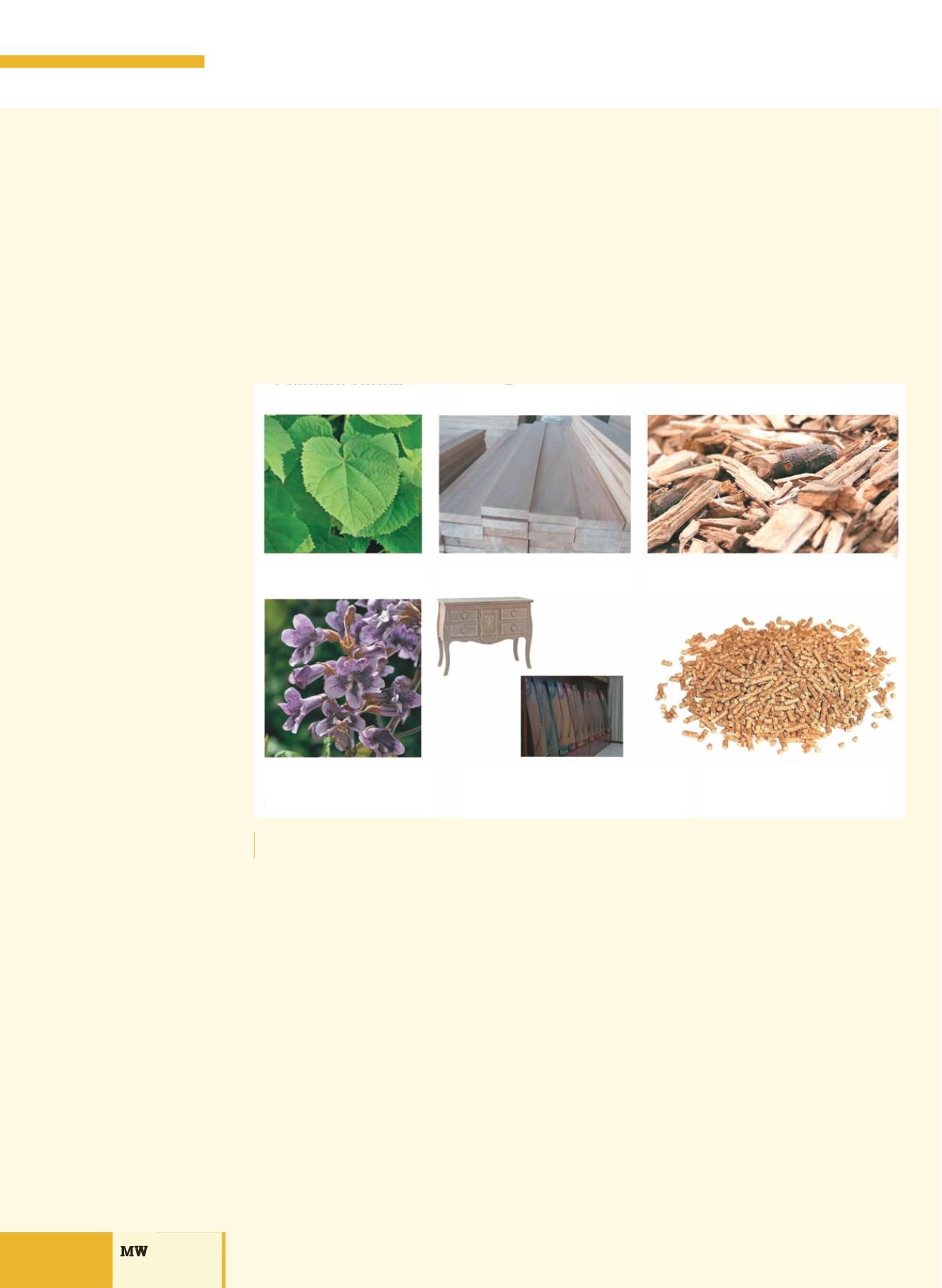

102
n. 12/2016
TECNICA
La Paulownia tomentosa, nota anche con il nome italianizzato di “Paulonia”,
è stata introdotta in Europa dalla Compagnia Olandese delle Indie Orientali;
la sua denominazione si deve alla dedica ad Anna Pavlovna, figlia dello Zar
Paolo I. Diffusasi in Italia a metà del 1800 come specie ornamentale, la Pau-
lownia è a maturità un albero dal portamento maestoso, caratterizzato da fo-
glie grandi cuoriformi e fiori molto decorativi e profumati.
Per molto tempo la Paulownia ha quindi rivestito un mero ruolo orna-
mentale, ma più di recente è stata apprezzata anche come essenza adat-
ta alla produzione di materiale da opera, grazie alla notevole leggerezza,
all’elevata flessibilità e alla grande durata del legno, che dopo la prima la-
vorazione si presenta bianco, sostanzialmente privo di venature, nodi e di-
fetti. Mostra inoltre un’eleva-
ta resistenza al fuoco, è repel-
lente e inattaccabile dalla
maggior parte degli insetti xi-
lofagi, ed è in generale molto
resistente a parassiti e muffe.
Il legno di Paulownia ha un
elevato contenuto di acqua al-
la raccolta (massa volumica di
800 kg/m³, 30% di umidità),
ma si essicca molto veloce-
mente all’aperto in modo na-
turale, tanto che in condizioni
idonee dopo solo un mese cir-
ca scende al 12-15% di umi-
dità e a 350-400 kg/m³ di
densità. Questo materiale è in-
dicato per realizzare rivestimenti
interni o serramenti, ma anche
per fabbricare mobili, pannelli
truciolati, pasta da carta, ecc.
Inoltre, grazie alla struttura
uniforme è adatto per costruire
strumenti musicali e più in ge-
nerale oggetti che richiedano la-
vorazioni di precisione.
Dal punto di vista ambientale,
molto interessante è il suo im-
piego per il consolidamento del-
le zone franose, grazie alle radici fittonanti a rapidissimo sviluppo, mentre la sua
chioma imponente ben si presta alla creazione di siepi frangivento. La maesto-
sa fioritura delle coltivazioni di Paulownia è utile anche in apicoltura, tanto che
si possono ricavare fino a 1000 kg/ha di miele. La principale peculiarità di que-
sta essenza è però la sua crescita estremamente rapida: in condizioni ottimali,
può arrivare a 15 m di altezza in soli 3 anni dalla messa a dimora. Si presta quin-
di molto bene alla produzione di biomassa a fini energetici in SRF (Short Rota-
tion Forestry), con l’unico limite rappresentato dall’elevata quantità di acqua
contenuta nel legno giovane appena reciso.Tra l’altro, le foglie possono essere
sfruttate per l’alimentazione animale, mentre oltre ad essere melliferi i fiori of-
frono per estrazione anche alcuni principi medicinali.
The Paulownia tomentosa, in Italy also known as “Paulonia”, was brought
to Europe by the Dutch East India Company. The tree owes its name to An-
na Pavlovna, daughter of the Tzar Paul I.The Paulownia became widespread
in Italy in the mid 1800s as an ornamental species. In fact when it reach-
es full maturity is an imposing plant, characterized by large heart-shaped
leaves and by very decorative and fragrant flowers.
For a long time the Paulownia was used merely for its ornamental function,
but more recently it has attracted much attention as a species that provides
timber, characterized by remarkable lightness, a high degree of flexibility and
durability.The first stage in processing yields a white wood that presents hard-
ly any grains, knots or defects. It is furthermore highly resistant to fire, it is re-
pellent and resistant to most xylophage insects, and is generally resistant to
parasites and moulds. The wood of the Paulownia has a high water content
when first harvested (bulk density is 800 kg/m³, with humidity at 30%), but
it can be dried very quickly and naturally in the open, so much that in ideal
conditions in about only one month humidity drops to 12-15% and density
to 350-400 kg/m³. This material is indicated for the production of interior fur-
nishings, doors and window frames, but also the manufacture furniture, par-
ticle boards, wood pulp, etc. Furthermore, thanks to its uniform structure, it
can also be used to make musical instruments and more in general objects
that require a high degree of precision during processing.
From an environmental point of view it is interesting to note that this tree
is very much employed in securing areas subject to landslides, because of
its very strong taproot which grows very quickly, while its luxuriant foliage
is very suitable for the creation of wind-breaks. The impressive blossoming
of the Paulownia species is also very useful in beekeeping, in fact it is pos-
sible to obtain up to 1000 kg/ha of savoury honey.
The main peculiarity of this species is however its extremely rapid growth:
in good conditions the tree can reach 15 m in hight in only three years. It
is, for this reason, a very recommended plant for the production of biomass
for energy purposes in short rotation forestry, the only limitation being the
high amount of water contained in the young wood soon after harvest. Fi-
nally, the leaves can be used to feed animals, while the flowers are not on-
ly melliferous, but can also be used for extracting active ingredients.
Una pianta
multifunzionale
A
multifunctional
plant
Le numerose forme di impiego della Paulownia tomentosa
The numerous uses of the Paulownia tomentosa
foglie (alimentazione animale) /
leaf (animal feed)
fiori (produzione miele,
estrazione essenza)
flower (honey production, essence
extraction)
mobili e strumenti musicali
forniture musical instruments
pellet
PARTI VEGETALI
PLANT PARTS
LEGNO
WOOD
BIOMASSA
BIOMASS
legname da costruzione /
contruction timber
cippato /
woodchips
















